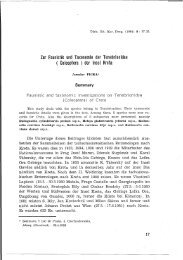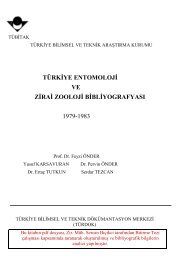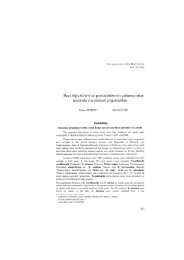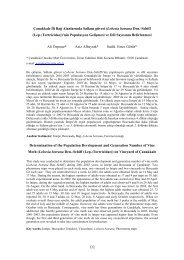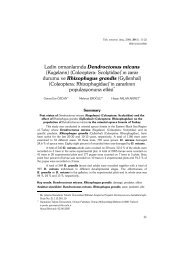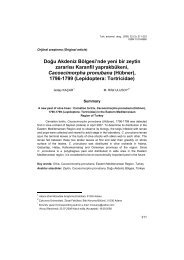Trichogramma evanescens
Trichogramma evanescens
Trichogramma evanescens
You also want an ePaper? Increase the reach of your titles
YUMPU automatically turns print PDFs into web optimized ePapers that Google loves.
quickly and affordably relative to other parasitoids (Li, 1994; Smith, 1996).<br />
Augmentative release of <strong>Trichogramma</strong> wasps offers a promising new approach<br />
for managing stored-product moths (Grieshop et al., 2006). The polyphagous egg<br />
parasitoid <strong>Trichogramma</strong> <strong>evanescens</strong> (Westwood, 1833) (Hymenoptera:<br />
<strong>Trichogramma</strong>tidae) are commercially applied in the retail trade and the food<br />
processing industry in Germany to control stored-product moths, mainly the Indian<br />
meal moth Plodia interpunctella (Hübner) (Lepidoptera: Pyralidae), the<br />
Mediterranean flour moth Ephestia kuehniella Zeller (Lepidoptera: Pyralidae),<br />
and the warehouse moth Ephestia elutella (Hübner) (Prozell & Schöller, 1998)<br />
(Lepidoptera: Pyralidae). Steidle et al. (2001) <strong>Trichogramma</strong> species<br />
(<strong>Trichogramma</strong> brassicae Bezdenko, <strong>Trichogramma</strong> pretiosum Riley and<br />
<strong>Trichogramma</strong> carverae Oatman & Pinto) were assessed for their suitability as<br />
bio-control agents against Ephestia cautella (Walker) (Lepidoptera: Pyralidae)<br />
and E. kuehniella which are important pests in food manufacturing and<br />
processing facilities in Australia.<br />
The egg parasitoid <strong>Trichogramma</strong> as a biological control agent requires<br />
that large numbers should be produced by commercial insectaries. Because field<br />
requirements can vary, it is desirable to store large numbers of parasitoids to meet a<br />
fluctuating demand (Bradley et al., 2004). Storage of these parasitoids assures their<br />
availability in sufficient numbers at the time of release (Tezze & Botto, 2004). Cold<br />
storage can permit a more cost-effective production schedule (Glenister &<br />
Hoffmann, 1998). It may also be a means to conserve biological control agents<br />
when not immediately needed (Pitcher et al., 2002). The variation in<br />
<strong>Trichogramma</strong> strains for cold tolerance and adaptability to low temperatures<br />
makes this a useful criterion for evaluation of candidate strains for inundative<br />
releases in cold conditions (Voegelé et al., 1988). A number of <strong>Trichogramma</strong><br />
species have been tested by exposing the insects to cold storage conditions (Vigil,<br />
1971; Jalali & Singh, 1992; Piao et al., 1992; Bradley et al., 2004; Özder &<br />
Sağlam, 2004; Kumar et al., 2005; Karabörklü & Ayvaz, 2007). Much of these<br />
studies report the amenability of the immature stages of <strong>Trichogramma</strong> species<br />
against cold storage. It is important to test the suitability of each particular species to<br />
cold since not all of them are able to be cold stored (Tezze & Botto, 2004).<br />
Few studies were reported on the cold tolerance of the <strong>Trichogramma</strong><br />
adults. The determination of cold tolerance of the adult parasitoids would be useful<br />
for some parasitoid release programs. Because, conservation of adult biological<br />
control agents would be applicable when the weather conditions changed<br />
unexpectedly during release period. We aimed to determine the amenability of<br />
T. <strong>evanescens</strong> adults to the cold and to estimate the effect of such storage on the<br />
quality of the adult parasitoid and its F1 progeny. In the current study, we have<br />
tested the tolerance of T. <strong>evanescens</strong> adults at low temperature and determined<br />
parasitization rate, longevity, emergence and sex ratio after cold storage.<br />
270



